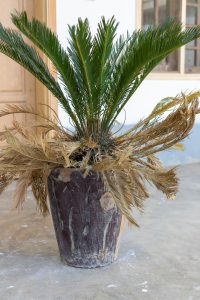Exotic-looking, stunning, and easy to maintain, sago palms are commonly found in residential and commercial settings. Though they are technically not palms at all but rather cycads, these popular landscape plants have a palm-like appearance that gives off a tropical vibe. Although beautiful, these plants are strangely unique, which often confuses even the most experienced gardeners.
For other plants, when they start losing their leaves, it’s a pretty clear sign that they’re dying. However, if you’ve noticed this happening to your sago palm, don’t dig it up, at least not just yet.
How to Tell if a Sago Palm is Dead?
Characterized by their long, dark green leaves, sago palms are known for being tough and resilient. Its palm-like leaves are arranged in a circular pattern around the trunk. At its best, its leaves are vibrantly green, giving off an air of sophistication.
Although this may look alarming, from time to time, the foliage may completely drop off. This may happen once the temperatures dip below 19 degrees Fahrenheit. The cold weather causes the plant’s metabolism to shut down, and as a result, the leaves turn brown, slowly working their way down the plant. If this is the case, then there’s no need to worry, as your sago palm will likely bounce back, albeit slowly.
When this happens, make sure that you cut off its dead foliage. It’s important to do this so that the plant can focus its energy on growing new leaves rather than trying to revive the old ones. Even if it means that all you’ll have left from the plant is the trunk, don’t worry, as the sago palm will eventually grow new leaves.
If your plant is showing signs of distress, whether from a sudden temperature drop or a transplant, here are some things to watch out for and some ways to tell if your sago palm is beyond help.
Check the Terminal Buds
The first thing you’ll want to do is check the terminal buds, which are located at the top of the trunk, just in the center of the plant. Most of the time, these terminal buds are protected by a brown, papery covering. If this covering is brown and brittle, it’s a sign that the plant is dying.
On the other hand, if the terminal bud is soft, green, and fleshy, it’s a good sign that the plant is still alive.
Check for New Growth
While you’re at it, you should also check for new growth. Take note that some of the newly growing leaves may not be as green as the older ones. Most new growth typically shows up in the spring. You’ll see them sprouting at the top of the trunk. Even if you see one or two new leaves, it’s a good sign that the plant is still alive, and new leaves will come in eventually.
Take a Look at the Trunk
The next thing you’ll want to do is take a look at the trunk of the plant. If the trunk is soft and spongy, and there are no new leaves growing, it’s a sign that the plant is dead.
On the other hand, if the trunk is firm and there are new leaves growing, it’s a good sign that the plant is still alive, and you can still save it.
How to Revive a Dying Sago Palm
If you’re one of the unfortunate few whose sago palm has died, don’t fret, as there’s still a chance you can revive it.
As mentioned earlier, get rid of all the dead leaves. You want your plant to focus its energy on strengthening the roots and growing new leaves. When you don’t get rid of the dead leaves, it’ll just drain the plant’s energy, and it’ll be more difficult for it to recover.
Overwatering and underwatering are two of the most common reasons why plants die. If you think your sago palm has died from overwatering, hold off watering and wait for at least 3 weeks to see if there are any improvements.
You may also want to inspect the plant for spider mites. This is one of the most common pests that attack sago palms. You’ll know your plant has it when the leaves have white spots all across. A homemade mixture of water and dish soap can help get rid of them. Neem or insecticidal soap can also help address this issue.
If you think your sago palm has died from underwatering, give it a good soak in lukewarm water. Let the plant sit in the water for about an hour so that the roots can absorb as much water as possible. After that, drain the excess water and wait for the plant to dry before giving it another good soak. Do this once a week for two weeks, and you should see some improvements.
How to Tell if a Sago Palm is Dead: Final Thoughts
As frustrating as it is to see your beloved sago palm dying, there’s still hope. Patience, partnered with extra care and attention, can help revive a dying sago palm. With the proper knowledge of what to look for and what to do, you can save your plant and still enjoy its beauty for longer periods.
Consider checking the signs listed above to get an idea of whether or not your sago palm is beyond help. If you’re still not sure, it never hurts to ask for a second opinion from a professional. They’ll be able to give you a more accurate diagnosis and tell you what needs to be done to save your plant. Sago palms are a small variety of palm tree that looks great in any yard or landscaping project.

